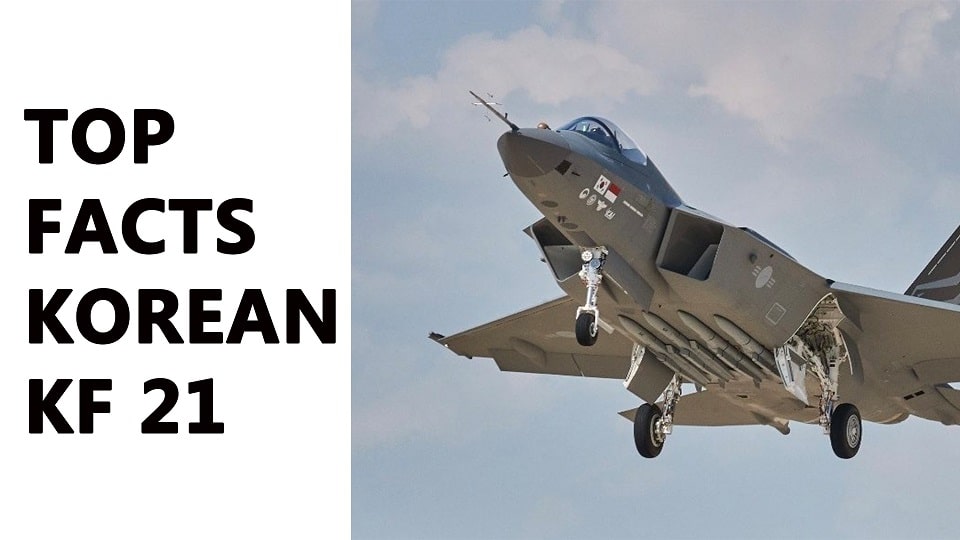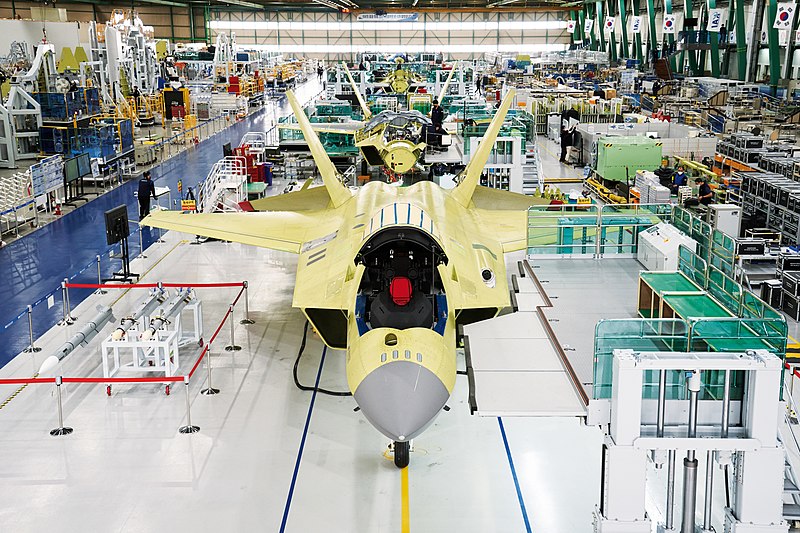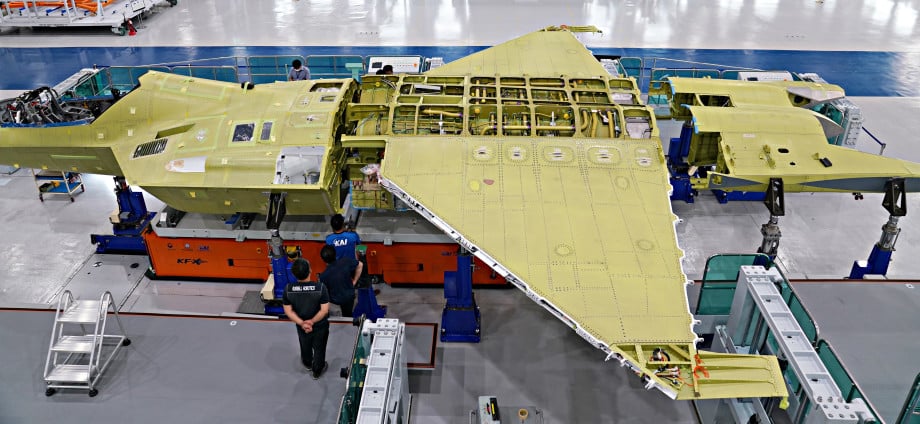Aviation
Top 8 facts about South Korean KF 21 Fighter jet: Specification, Partnerships, Weapons, and capacity

1. It took its first maiden flight in July 2022.
The Korean Aerospace Industries built the air superiority fighter KF 21 Bormae with Indonesia’s assistance. Its airframe is more stealthy than any fourth-generation fighter, but unlike fifth-generation fighters, it does not carry weapons through an internal bay.
It made its first flight from the production facility on July 19, 2022. The Korean name Bormae translates to “young Hawk” in English. At least 40 aircraft are expected to be delivered by 2028, according to the report. but it will also be offered on the international market.
2.It is a 4.5 Generation fighter jet.
To replace the outdated F4 and F5 fighter fleet, an alternative fighter is being developed for the Republic of Korea’s air force. It is a multirole fighter jet of the 4.5 generation, the source said. Initially, South Korea sought to develop a fighter aircraft that could outperform the Typhoon and Dassault Rafale.
Technically speaking, though, it necessitated extensive study and creation. They nevertheless made an effort to design a plane that would compete with the F16 Fighting Falcon in terms of combat range, a 34% longer airframe, and better weaponry.
3.Indonesia is a partener for KF 21 progrm.
Most nations cooperate in the program to lessen the burden of the financial aspects because it takes proper investments to develop any technology. In KF X, Indonesia joined the regional program in 2010 as per a committee agreement for 20% ownership. Later, however, KAI claimed that it had not made the agreed-upon payments. Later, an agreement was reached between Indonesia and South Korea to create a new cost-sharing plan by 2022.
4. KF 21 backed by Lockheed martin
The KF-21 program is supported by American titan Lockheed Martin, which is supplying the program with a number of design consultancy components. The staggering list of imported systems, along with numerous industrial-grade tools and consultancy to rely on for technical developments, includes everything from brake pads to flight controls systems, LRUs, landing gear, avionics, canopies, oxygen generators, radar, engines, ejection seats, and even the aircraft’s software management system.
As part of a purchase agreement, Lockheed Martin consented to transfer two dozen F-35A technologies. Four crucial technologies, AESA radar, infrared search and track (IRST), electro-optical targeting pod (EO TGP), and radio frequency identification (RFID), were, however, prohibited from export by the US government.
5. Stealth Fighter variant by 2035.
According to KAI, most of the systems may have been locally indigenous by the time the KF-21 Block III, which is expected to be a true stealth fighter variant by 2035, is released. However, until that time, the KF-21 is just a 4.5-generation fighter jet with elements of the 5th generation fighter, which is still being developed. Though the program is heavily supported by American defense industrial partners, which would still be under US control, must still be acknowledged. It will also take until 2035 before KAI has its own domestically developed technology.
6. Expensive military project in Korean history
Indonesia is said to be asked to reduce its share in the joint investment and development of the KF-21 by 5 percent and for more technology transfers than stipulated in the original agreement. The development of the KF-21 has been called the most expensive military project in Korean history, with a price tag of approximately 8.5 trillion won ($7.8 billion) for development alone. According to the government, 719 Korean businesses have participated in the development of the KF-21. About 65 percent of over 30,000 parts used in the prototype aircraft were made in Korea.
Features
The KF 21 can be operated by a single and double crew.
- It is 15 feet 5 inches tall, 55 feet 5 inches long, and has a wingspan of 36 feet 9 inches.
- It weighs 18,800 kg when empty and can support a maximum weight of 25,400 kg.
- It had a 2 GE 414 engine that can produce 57.8 kilonewtons without an afterburner and 97.9 kilonewtons with one.
- It has a range of 2,900 km and a top speed of Mach 1.81.
Speaking about the weapon package of the KF 21
- It has ten Hard points. which is equipped with air-to-air missiles such as the MBDA, AIM 120, Diehl IRIS, and AIM 9x.
- It features anti-ship missiles like AGM 84 Harpoon and air-to-ground missiles like Taurus and AGM-65.
- It is capable of transporting conventional and precision-guided bombs like JDAM, GBU, and KGGB.
Avionics
The KF 21 fighter jet has AESA radar, an infrared search and track system, an electro-optical targeting pod, datalink capabilities, a radiofrequency jammer, and many more characteristics. It is estimates the cost of the KF-21 at $65 million per unit.
Please share your thoughts on the Korean-built KF 21 fighter plane in the comments area.

Aviation
COMAC Unveils Plans for the C929 to Rival Airbus and Boeing

After the success of China’s first C919 aircraft, the country is setting its sights on developing a larger plane. COMAC (Commercial Aircraft Corporation of China) has officially confirmed plans to build a widebody aircraft, marking a significant step in its aircraft lineup.
Traditionally, Airbus and Boeing dominate the widebody aircraft market, with decades of expertise in developing planes and engines capable of carrying heavy payloads. China, which currently relies on imported engines, is now aiming to challenge these giants with its own widebody jet, the C929, designed to compete with the Airbus A350 and Boeing 777.
American Airlines Is Looking for Flight Attendants: Apply Now
The C929 will be China’s first independently developed long-range widebody aircraft. It adheres to international airworthiness standards and boasts independent intellectual property rights. The baseline version is designed to seat 280 passengers and offers a range of 12,000 kilometers, catering to global demand for both regional and international air travel.
Russia, which also needs reliable narrowbody and widebody aircraft, could become a key customer for the C929. Additionally, China plans to target the broader Asian market as it continues to expand its aviation capabilities.
Close Call at Heathrow: BA Flight Narrowly Escapes Drone Collision
China’s aviation progress includes the ARJ21 (now called C909), a regional jet with 100 seats for shorter routes, and the C919, a narrowbody jet with 180 seats designed to rival the Boeing 737 MAX and Airbus A320. Both models have found increasing demand in the domestic market.
At China’s largest air show in Zhuhai, COMAC announced that Air China will be the launch customer for the C929 widebody jet, though details about order size and delivery timelines were not disclosed.
Other major deals announced by COMAC include:
- Hainan Airlines: Firm orders for 60 C919 and 40 C909 regional jets.
- Colorful Guizhou Airlines: 30 C909 jets, with 20 firm orders and 10 provisional agreements.
The C929, renamed from the CR929 after Russia withdrew from the joint development project in 2023, is expected to carry 280–400 passengers with a range of 12,000 kilometers, competing directly with Boeing’s 787 Dreamliner.
According to COMAC’s deputy general manager, Tong Yu, the first fuselage section of the C929 is expected by September 2027, with prototype test flights anticipated soon after.
-

 Aviation2 months ago
Aviation2 months agoMicrosoft Flight Simulator Raises $3 Million to Bring Back the An-225 Mriya
-

 Airlines2 months ago
Airlines2 months agoQantas Engineers Stage Walkout Over Cost of Living Concerns
-

 Airlines2 months ago
Airlines2 months agoQatar Citizens Can Travel to the United States Without a Visa
-

 Aviation2 months ago
Aviation2 months agoQatar Airways bans these new Electronic Devices on plane
-

 Airlines2 months ago
Airlines2 months agoJapan Airlines Rolls Out Free Domestic Flights to International Passengers
-

 Defence2 months ago
Defence2 months agoWhich Country Has the Largest Fleet of Fighter Aircraft?
-

 Airport2 months ago
Airport2 months agoWestern Sydney Airport Welcomes Its First Plane After 6 Years of construction
-

 Travel2 months ago
Travel2 months agoQatar Airways Launches Four Additional Flights from Amsterdam











